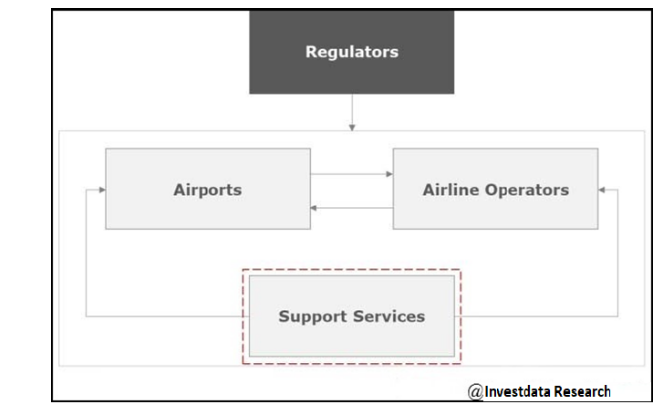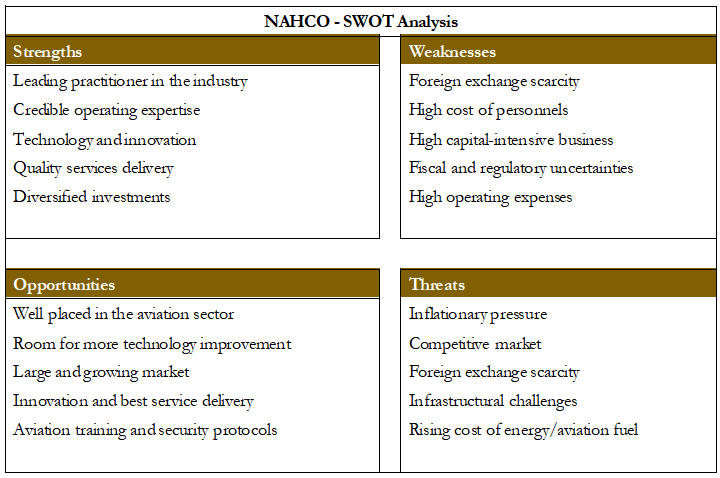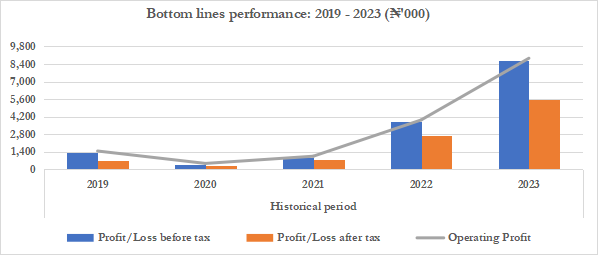In this report, we initiate a coverage on Nigerian Aviation Handling Company Plc (NAHCO) to unveil the fundamentals and prospects (in terms of right pricing) of the company’s shares going forward.
Overview of Nigerian Aviation Ground Handling Sector:
Civil aviation forms a core part of Nigeria’s transportation system and is a critical driver of economic growth in Africa’s most populous country and of its largest economies. Nigeria is an important destination for over 22 foreign carriers, besides currently having Bilateral Air Services Agreements (BASA) with over 78 countries.
The Nigerian Aviation industry has recorded tremendous growth over the years, buoyed by the country’s drive towards global economic integration with a four-year average passenger traffic (domestic and overseas) of 14.7 million. There were over 20 local and domestic airlines operating in the country and over 20 airports, as well as a significant number of regulated airstrips and heliports. From Nigeria, air travellers can fly directly to many of the world’s business centres such as London, Paris, Frankfurt, New York, Johannesburg, Atlanta, Amsterdam, Dubai, and Jeddah to mention a few.
In 2022, the industry experienced a lot of developments, working to overcome various challenges. A very notable development was the assent to the Civil Aviation Act, 2022 by President Muhammadu Buhari. The Act repeals the Civil Aviation Act, No. 6, 2006, enacting the Civil Aviation Act, 2022 which establishes an effective regulatory and institutional framework for the regulation of civil aviation in Nigeria with a view to promoting industrial safety and security, assuring that Nigeria’s obligations under international aviation agreements are carried out, and consolidating the law relating to civil aviation regulation in Nigeria.
More recently, the International Air Transport Association (IATA) in its global passenger traffic report for December 2023 stated that Nigerian airlines, and other regional airlines recorded 9.5% year-on-year (y/y) increase in passenger traffic. However this level is still at 93.4% of pre-Covid level in 2019.
Meanwhile, GDP data for Q4-2023 sourced from the Nigeria’s National Bureau of Statistics (NBS) shows that Air Transport contracted by -1.6% y/y but grew by 7.38% y/y for FY-2023. The segment accounted for 11.1% of total Transport GDP in 2023. Over the past eight quarters, the segment grew by an average of 16 .5%. It was the second fastest growing segment within transportation sector in 2023, following water transport.
The current growth in the sectors as well as the compelling investment opportunity in the industry continues to attract new entrants as evinced by the unveiling of two recent domestic airline operators and several other aviation support service providers. The consistent growth in the demand and supply sides of the industry driven by innovation and best-in-class service delivery.
The outlook for the industry remains positive having accorded the U.S. Federal Aviation Administration’s (FAA) International Aviation Safety Assessment Category One (ISAC-1) certification (which permits Nigerian registered carriers to fly directly into the United States). Also, the Federal Government’s focus on strategically re-positioning the industry within the West African region to play its expected pivotal role of driving growth in key economic sectors and overall economic transformation.
Nigeria’s aviation industry can be segmented into the airline operators, airports, the regulators, and the support service providers. The ground handling sector forms a part of the support service providers in the industry.
Figure 1: Structure of the Nigerian Aviation Industry

Growth within the ground handling space in the aviation industry is largely driven by activities of airline operators (passenger and cargo). The developments within the Nigerian Aviation industry around privatization of major airports, international safety certifications and regulations focused on improving the ease of doing business within the industry are expected to attract new airline carriers, expand the activities of existing carriers; these will consequently increase passenger and cargo traffic and portend significant growth opportunities for the Grounds Handling space.
The Nigerian Grounds Handling sector is largely structured as a duopoly with NAHCO and Skyway Aviation Handling Company (SAHCO) as the main players. In recent times, the sector has attracted foreign players as well as other domestic competitors, although their entry has been handicapped by significant regulatory hurdles which serve as a major barrier to entry. Nevertheless, the country’s drive to improve the ease of doing business is expected to lessen the regulatory hurdles and increase the number of participants in the ground handling business going forward.
Following significant recovery from the effect of the recent pandemic, substantial payment of International Airlines’ Foreign Exchange (FX) debt, and improved macroeconomic fundamentals (including tightening of the spread between parallel and official FX rates, robust economic growth forecast, among others). This creates a favourable backdrop for business activities and operations as well as the expected holistic growth of the aviation industry, the Nigerian Ground Handling sector is expected to continue to thrive and record new levels of sustainable growth and profitability.
Overview of the Company
The Nigerian Aviation Handling Company Plc (NAHCO) is West Africa’s leading ground handling service provider with presence in all major Nigerian airports. Founded in December 1979, it has since grown into a multi-billion Naira company with diversified investments in energy, logistics, food and beverages, aviation training and development of a free trade zone company.
At inception the Federal Government through the Federal Airports Authority of Nigeria (FAAN) had the majority equity interest of 60% while four foreign airlines – Air France, British Airways, Sabena, and Lufthansa – shared the remaining 40 percent in various ratios. NAHCO Plc has since gone through changes in its ownership structure, following the sale of Government stakes through the privatization exercise of 2005.
Over the years, NAHCO has upped the game in aviation support services through increased investment in state-of-the-art aviation ground handling apparatus, manpower training, excellent customer services and establishment of an ultra-modern cargo imports and exports warehouses. It is worthy of note that the company has been foremost in aviation ground handling initiatives and developments. It was the first ground handling company in West Africa to receive IATA’s Safety Audit for Ground Operations (ISAGO) certification – the aviation industry’s highest safety honours. The company was also the first ground handling company in Nigeria and indeed the whole of West Africa to attain the EU’s Regulated Agent Third Country (RA3) certification.
In recognition of the NAHCO’s pivotal role in ground handling activities, global and domestic aviation regulators and advocates have accorded the companies numerous awards among which are Nigerian Aviation (NIGAV) Awards, 2021, 2019, and 2018 for Best Airport Ground Handling Company; Air Transport Award, 2021 for the Most Resilient Aviation Company; and the International Trophy for Quality, 2018 awarded by Global Trade Club, Madrid, Spain.
NAHCO has remained consistent for over 45 years, providing top notch services to its numerous customers, contributing to industry growth as well as that of the communities where it operates from. It has a significant presence in all the functional airports across the country.
Shareholding and Operational Structure
The company currently has more than 80,000 shareholders listed on The Nigerian Exchange Limited (NGX) with the symbol ‘NAHCO’. The company’s authorized share capital currently stands at N974.53 million, comprising 1.95 billion ordinary shares of 50 kobo each. The entire issued and fully paid-up share capital of the company is registered with the Securities and Exchange Commission (SEC) of Nigeria. Three institutional investors hold more than 5% of the total shares of the company. These major investors are Godsmart Nigeria Limited – 26.95%; White Cowries Industries Limited – 9.17%; and AWHUA Resources Limited – 7.13%.
NAHCO’s operational structure is designed to achieve seamless growth and maximum efficiency. The company’s Board of Directors, led by the chairman set the strategic direction of the company and provides general oversight over its operations while the statutory responsibilities for the day-to-day management are performed through the office of the Managing Director. The board comprises of 12 directors, comprising six Non-Executive Directors, three Independent Non-Directors, and three Executive Directors. The composition of the Board is diverse and gender inclusive. The Directors possess high level of competencies and experience, with impressive records of achievement, spanning across various industries including law; engineering; finance and accounting; business administration; marketing; banking and entrepreneurship.
Service offering
NAHCO offers a comprehensive portfolios of aviation handling services, among which are; Aircraft Handling; Passenger Handling, Cargo Handling, Aviation Training and Security, Aircraft Disinfection, Charter Operations and Premium Lounge, and Energy and Power Distribution and Leasing of Ground Handling Equipment. The company has consistently invested heavily in the acquisition of more Ground Support Equipment (GSE) to boost her operations. NAHCO places a high premium on safety and security of passengers and their luggage in line with international conventions and standards.
Geographical reach
NAHCO has operations across Nigeria with significant presence in all commercially operated airports in the country, with a wide network efficiency covering the four operational regions: central, northern, eastern, and western.
Competitive edge of NAHCO
Our analysis of NAHCO’s SWOT (Strengths, Weaknesses, Opportunities, and Threats) reveals considerable potentials driven by Nigeria’s growing population of air travellers. However, the foreign exchange scarcity, inflationary pressure, and the infrastructural gaps needs to be addressed to enable companies operating in the sector or industry such as NAHCO reach full potential.

Figure 2: NAHCO’s SWOT analysis
Financial Analysis 2019 – 2023
Powered by increased passenger/aircraft handling:
Markedly, the four major income sources: passenger/aircraft handling; cargo handling; leasing/disinfection services; and equipment rental and maintenance services have witnessed leaps and bounds growth over the years. In the recent five years, NAHCO’s revenue rose from N9.99 billion in 2019 to N28.40 billion in 2023, representing a CAGR of 23.2%. This level of growth was significantly aided by the passenger/aircraft handling services (growing by +225.6% between FY ’19 and FY ’23), and cargo handling services (growing by +81.3% between FY ’19 and FY ’23). The other two income categories are not left out. Equipment rental and maintenance services advanced by +304.8% in the period but contributed 6.05% to the entire revenue in FY ’23. For leasing and disinfection services, it grew by grew by +525.5% and contributed 5.78% to the revenue in FY ’23. Note that passenger/aircraft handling services contributed 62.9% to the entire revenue in FY ’23, while equipment rental and maintenance services contributed 25.3% to the revenue.

Source: NAHCO’s financials data, Investdata Research
Knock-on effect of robust revenue and cost efficiency boosted core profits:
Over the last five years, while revenue grew by a CAGR of 23.2%, operating costs and administrative expenses grew by a CAGR of 15.3% and 19.2%, respectively. The subdued growth of the core expenses above helped to bolster core profit lines. For context, gross profit and operating profit grew by a CAGR of 34.3% and 43.3% to settle at N15.0 billion and N8.86 billion, respectively. This level of performance is commendable considering the effect of inflationary pressure (which rose from 11.37% in Jan. ’19 to settle at 28.92% in Dec. ’23) on operating costs. Another cost headwind in the period was exchange rate volatility (which rose from N363.03/US$ in Jan. ’19 to N907.11/US$ in Dec. ’23), mounting immerse pressure on cost of doing business in Nigeria.

Source: NAHCO’s financials data, Investdata Research
Efficiency in costs control strengthens bottom lines and margins:
Markedly, improvement in income heads, and cost control efficiency helped to put a lid on earlier concerns on total operating expenses (OPEX). For context, OPEX margin sat at 91.01%, 100.93% and 92.30% in FY ’19, ’20, and ’21, respectively. With improvement in income heads, it dropped to 77.09% and 68.65% in FY ’22 and ’23, respectively. As such, profit before tax (PBT) posted a CAGR of 45.3% in the five years period, settling at N8.68 billion in FY ’23. For profit after tax (PAT), it posted a CAGR of 50.5% in the period under review to settle at N5.54 billion in FY ’23.

Source: NAHCO’s financials data, Investdata Research
Margins and ratios performance mixed
While profitable margins improved within the period under review, leverage ratios recorded mixed performance. Profitability margins were driven by efficiency recorded on income line items as earlier identified. For leverage ratios: interest coverage ratio (ICR) for instance rose from 4.89x in FY ’29 to 43.86x in FY ’23, indicating that NAHCO’s ability to honour its debt obligations as they fall due is not in doubt. To put it in context, the company had capacity to meet her finance costs’ obligation 43.86 times in FY ‘23. However, looking at debt-to-equity ratio, they are developing concerns as we observed that the ratio is nearing intolerable point. It has risen from 1.07x in FY ’22 to 1.25x in FY ’23 amid overdraft facility obtained from GTCO (N1.50 billion with a tenor of 12 months, at an interest rate of 19% per annum), trade and other payables (totaled at N8.67 billion). Management needs to watch the above lines.

Source: NAHCO’s financials data, Investdata Research
Net and total assets continue to look up:
In the five years under review, NAHCO’s Total Assets (TA) rose by a CAGR of 13.2% to settle at ₦27.31 billion. Growth here was chiefly driven by short-term’s trade & other receivables (which advanced by +298.5%); and long term’s property, plant, and equipment (with valuation increasing by +10.8%). As at FY ‘23, the short-term’s trade & other receivables constituted 54.1% of Current Assets (CA), reinforcing the earlier highlight that the company has strong capacity to meet its short-term obligations as they fall due. On the order way round, Total liabilities (TL) rose by a CAGR of 13.5% to ₦15.18 billion. However, in percentage terms, TL grew by 88.05% from FY ’19 to FY ’23, was mostly driven by trade and other payables (which rose by 76.9%). With the momentous weight of TA over TL, Shareholders’ fund grew by a CAGR of 12.1% to settle at ₦12.13 billion. As such, return on asset (ROA) jumped from 4.9% in FY ’19 to 20.3% in FY ’23.

Source: NAHCO’s financials data, Investdata Research
FY-2023 Financial Highlights: revenue bolstered by y/y growth on segment sales:
In the recent FY ’23 results, revenue jumped by 70.0% to ₦28.40 billion, and was bolstered by improved sales recorded by the two major business segments: passenger/aircraft handling services (at ₦17.86bn represents +62.9% of the total revenue); and cargo handling services (at ₦7.18bn represents +25.3% of the total revenue). Markedly, the passenger/aircraft handling’s ratio was higher than 58.2% achieved in FY ‘22. For cargo handling services, its’ share of the total revenue was lower than 23.1% achieved in FY ’22, amid increased in air ticketing fares following y/y uptick in aviation’s fuel, and the effect of the Naira devaluation. Price increase in luggage handling as traveling hits pre covid 19 level with the company diversification in food items export to major markets of the world will further boost its bottom line going into the future.
Other income line items grew by 115.1% y/y to settle at ₦754.92 million, clearly driven by FX gains (representing 67.5% of other income head). Operating profit grew by 124.9% y/y to settle at ₦8.86 billion.
Bottom line PBT rose by 125.9% y/y to settle at ₦8.68 billion. After accounting for tax obligation of ₦3.14 billion, PAT settled at ₦5.54 billion, representing 107.2% y/y growth over the number reported for FY ’22. As such, the earnings per share (EPS) for FY ’23 settled at 284 kobo, representing 107.37% growth over 137 kobo achieved in FY ’22.
The company’s Board of Directors has recommended a final dividend of ₦2.54 per share (vs ₦1.20 paid for FY ’22), translating to a dividend yield of 7.64% as of closing market price of ₦33.25 posted on Friday, 05 April 2024.
Valuation and recommendation:
We valued NAHCO using sum-of-the-parts valuation (SOTP) and relative valuation methodologies (RVM). Our RVM took cognizance of current price multiples of 11.70, the net book value of ₦6.22 and return-on-equity ratio of 45.56%. We then arrived at an equity value or target price (TP) of ₦37.50. This TP reflects a lower net debt position, improvements in net cash position, and increases in enterprise value over EBIT (operating profit).
At the TP above, NAHCO currently has an upward potential of 12.78% when compared to closing market price of ₦33.25 posted on Friday, 05 April 2024. Based on the above valuation, we therefore place a BUY rating on the company’s shares at current market price of ₦33.25 per share.
Note: our waiting period for this target is FY ’24, and it is subject to a review as data regarding the company’s financials are collated.









